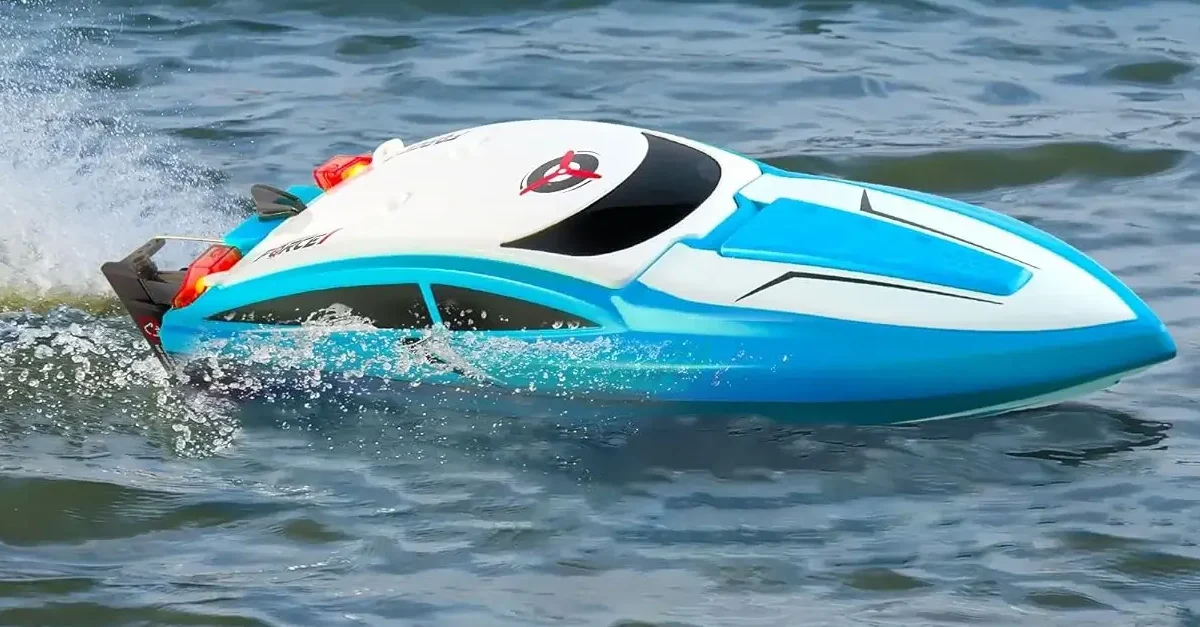Plunge into the captivating realm of miniature RC boats, where high-speed adventure meets the convenience of your local waterways. These compact and agile vessels are engineered for thrill-seekers looking to experience the rush of racing without the need for expansive space.
Ideal for both beginners and seasoned racers, mini RC boats deliver the ultimate solution for remote-controlled fun on any pool, pond, or lake. Embrace the joy of quick turns and rapid maneuvers, all from the palm of your hand.
Join the miniature maritime realm and discover how these tiny titans can offer excitement. Are You ready for the 5 Best tips to start with Mini RC Boats?!
My 5 Best Tips to Start with Mini RC Boats
Embarking on the mini RC boat hobby can be as refreshing as a sea breeze, but knowing where to start ensures smooth sailing. Here are my 5 unique tips to help you navigate the waters of this exciting pastime:
- Understand Your Vessel:
Before you set sail, familiarize yourself with the anatomy of your mini RC boat. Learn about its components, such as the hull, rudder, propeller, and radio transmitter.
Understanding how these parts work together will improve your control and help you troubleshoot any issues. It’s also essential to know the capabilities and limits of your boat’s battery life to maximize your time on the water. - Start in Calm Waters:
Begin your journey in a controlled environment, like a small pond or a swimming pool, where external factors like waves or strong currents won’t affect your learning curve.
Calm waters will allow you to get a feel for the controls and behavior of your boat without the added challenge of unpredictable elements. - Practice Makes Perfect:
Don’t expect to be a master captain immediately. Spend time practicing basic maneuvers such as accelerating, turning, and reversing.
As you grow more confident, set up mini-courses using floating markers to hone your piloting skills. This practice will also help you understand how your boat reacts to different inputs and conditions. - Maintenance Matters:
Regular maintenance is crucial to maintaining your mini RC boat. Rinse your boat with fresh water after each use to prevent corrosion, especially if you’ve been boating in saltwater.
Check for loose parts, and ensure your battery and electronics are dry before storing. A well-maintained boat not only performs better but also lasts longer. - Join a Community:
One of the best ways to learn is by connecting with fellow enthusiasts. Joining a local RC boat club or online community can provide valuable advice, support, and friendship.
You’ll have access to a wealth of collective knowledge and experience, plus it’s a great way to discover new spots to pilot your vessel and possibly even participate in friendly races.
By following these 5 tips, you’ll be well on your way to mastering the art of mini RC boating. Remember that patience and persistence are your best allies in this hobby. With each outing, you’ll discover more joy and satisfaction as you deftly maneuver your mini craft across the water’s surface.
Anatomy of a Mini RC Boat

When I first got into the hobby of mini RC boating, I quickly learned how each component serves a particular function. These boats are marvels of engineering on a miniature scale, and understanding their anatomy can significantly enhance your knowledge and your experience on the water.
Hull Design
The hull is the boat’s core, designed intricately to carry all other components. Its design dictates the speed and stability of the mini RC boat. I’ve found that a well-designed hull efficiently cuts through water and can drastically improve the boat’s handling.
- V-Shaped Hulls: Common in racing models for cutting through waves
- Flat-Bottom Hulls: Offer stability, which is great for calm waters
Miniature RC Boats: A Complete Guide for Enthusiasts provides insights into different hull designs and their impact on performance.
Motor and Propeller
Next, the motor is the powerhouse, and choosing the right one is crucial for your desired speed. Most mini RC boats use an electric motor (ESC) for propulsion, though some may come with gas-powered alternatives.
The propeller, connected to the motor, moves the boat forward. It works by converting rotational power from the motor into thrust. The size and pitch of the propeller play a significant role in determining how fast and agile the boat is.
Control Systems
Finally, the essence of a mini RC boat’s functionality lies in its control systems. The remote control manages everything from the rudder’s angle to the speed, aiding in steering the ship.
- Rudder: The small but crucial part that steers the boat.
- ESC (Electronic Speed Controller): Regulates power to the motor and hence controls the speed.
Learning the functions of the control systems in an RC boat helped me significantly become a better operator. Remember, a solid understanding of these systems is what can distinguish a good RC boater from a great one.
Buying Guide for Mini RC Boats

When searching for the perfect mini RC boat, I focus on specific aspects such as size, performance, and durability. Let’s dive into what makes a wise purchase in this exciting hobby.
Size and Scale Considerations
When looking at mini RC boats, remember that size impacts maneuverability and where you can use them. Smaller RC boats are great for pools and small ponds, while larger models can handle expansive water bodies. Manufacturers usually provide the size specifications; going too small may limit your experience.
Performance features
The thrill of an RC boat lies in its speed and control. I prefer models with a powerful motor and responsive transmitter for optimal performance. Look for boats labeled Ready-to-Run (RTR) with all the necessary equipment, ensuring you get right to the action.
Durability and Material Quality
Durability is key. A sturdy construction and quality materials like ABS plastic can prevent damage from collisions or capsizing. Many options on Amazon mention whether a boat is waterproof—this is crucial for longevity.
Price Points and Brands
Mini RC boat prices vary widely. You can find affordable options under $50 and more sophisticated models at higher prices. The manufacturer can indicate the quality—reputable brands often equate to better design and lasting performance.
Maintenance and Upkeep
Maintenance is straightforward:
- Rinse with fresh water after use.
- Check for loose parts.
- Ensure the battery is charged.
Some boats come with 2.4GHz technology, offering a more stable connection and fewer interferences—ideal for when maintenance isn’t just about the hardware but also about keeping the technology in check.
Operating a Mini RC Boat

I’ve found that the joy of operating a mini RC boat is in the details. It’s not just about skimming your boat over water but mastering the controls and understanding the power that makes it all possible.
Starting Your Adventure
Before setting sail, you must ensure your boat’s battery is fully charged. I typically check that my LiPo or AA batteries are inserted correctly and have the required charge to avoid interruptions during my adventure. With my mini RC boat checked and ready, I launch it in either freshwater or saltwater, keeping in mind that saltwater can be harsher on the materials.
Controlling Your Boat
Controlling the boat is intuitive once you get the hang of it. The remote control functions like an extension of my own movements. I maneuver the boat by adjusting the throttle for speed and the steering for direction, always staying within the effective distance recommended to maintain a strong signal.
Battery and Power Management
To manage battery life and ensure maximum run time, I keep track of the charging time and make sure not to overcharge the batteries. Operating the boat at various speeds also helps; sudden starts and stops consume more power. Most importantly, I always keep a few spare charged batteries on hand, so the fun never ends prematurely.
Special Features and Advances in Mini RC Boating

As a mini RC boat enthusiast, I’ve seen technology constantly elevate the capabilities of these fascinating little vessels, making them more user-friendly, feature-rich, and fun for all skill levels.
Innovations in Mini RC Boating
Remote Control Boats: Remote control technology has significantly improved, offering greater ranges and more responsive steering. It’s not uncommon for a high-quality mini RC boat to have a control range of up to 150 meters, allowing for expansive play areas.
Stability and Performance: Many models now feature a self-righting feature that flips the boat back over if it capsizes, ensuring continuous play and easing fears of potential loss or damage. Additionally, advancements in hull design contribute to a more stable experience, even at higher speeds or in choppy water conditions.
Safety and Rescue Features
Capsize Recovery Mode: For beginners, a daunting prospect can be losing their mini RC boat due to a capsize. Thankfully, new models often come with a capsized recovery mode. With a simple flick of the controller, the boat rights itself, significantly reducing the chances of water damage and extending playtime.
RC Racing Boat Safety: Safety isn’t only about durability; it’s also about control during high-speed adventures. Nowadays, an RC racing boat is likely to have advanced features such as an emergency stop function. This contributes to a safer experience, especially during competitive racing, where things can get intense.
These advancements have made the world of mini RC boats easier to use and appealing, inviting a new wave of beginners to take the helm and navigate the thrilling waters of RC boating.
FAQ – Mini RC Boat

I’ve always been fascinated by the thrill of maneuvering a mini RC boat across the water. They’re perfect for hobbyists of all ages looking for fun and excitement. If you’re considering one for yourself or as a gift, there are a few things to remember. Here are some frequently asked questions that will help guide you through the world of remote-controlled boats.
What to look for when buying a remote-controlled boat?
Durability: A sturdy hull material like ABS plastic can withstand occasional impacts.
Size and Type: Consider where you’ll be using your boat; larger models may be suited for still water, while smaller boats can navigate more rugged environments.
Frequency: 2.4GHz radios are standard to avoid signal interference with other boaters.
Battery Life: Look for a decent balance between charge and play time.
What do you need for an RC boat?
To get started, you need:
The boat itself should include a radio transmitter.
A set of batteries or a rechargeable battery pack for both the boat and transmitter.
If you’re near large bodies of water, safety gear, such as a retrieval boat or a life vest.
Optional: Accessory tools like a stand for maintenance and extra propellers.
How fast can an RC boat go?
The speed of a RC boat can vary widely:
Beginner boats: 5-20 mph
Intermediate models: 20-30 mph
High-performance models: 30+ mph
Factors affecting speed include the boat’s design, weight, motor type, and power source.
How does an RC boat work?
A mini RC boat operates through a few key components:
Transmitter: I use this handheld device to send radio signals.
Receiver: Installed in the ship, this unit receives my inputs.
Motor(s): Propel the ship forward or help in steering.
Servos: These respond to my commands, operating the rudder, throttle, and sometimes other functions.
Set sail on the discussion and anchor your thoughts below – share your experiences and insights on mini RC boats in the comments.









